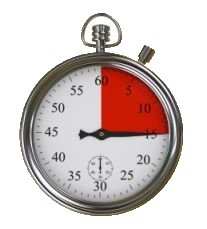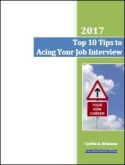Resume Formats
There are three readily accepted resume formats for organizing your resume:
While all of these formats are acceptable, experienced interviewers have some
very clear preferences. The links above will give you more detailed information
on these formats, but first, take a quick look at the style guidelines below to get
an overview of some of the Do's and Don'ts in creating your resume.
Look closely at this stopwatch. This is how much time you have to get my attention!
As a recruiter, I see hundreds of resumes on a weekly basis. And like other
experienced hiring managers, you only get about 15-20 seconds to catch my eye.
You read that correctly - 15-20 seconds is all I give to a resume that crosses my desk.
I'll make a decision on whether to consider you for a particular opportunity in the
blink of an eye.
Resume formats play an important part in what I see and what I miss.
If your resume is several pages long, I'll never get through it; likewise,
if there's not ample white space and a reasonable size font, I'm not going to even
try to read it.
Below are some style guidelines you should consider when putting your
resume together.
General Resume Format Guidelines
- Keep your resume to two pages. You really don't need more than two pages to showcase
your experience. Positions you held early in your career do not need as much detail as
those that are more current.
- Include all contact information, including cell phone and email. Here's a tip:
if your email is not professional (e.g. golferjoe@abc.com) - get a new one for the duration
of your job search. I offer the same advice for the greeting callers receive when you're not
available. Prospective employers do not want to hear your 3 year old asking them to leave
a message.
- Be consistent in your formatting.
- Use a font that's easy to read. I prefer Arial or Verdanna, although other straight
forward fonts will work.
- Vary the type style - use bold and italics to create some contrast. Make sure your
headings "pop".
- Use one inch margins.
- Include white space between major sections. Make your resume reader friendly.
- Have someone else proofread your resume. If there are mistakes on your resume,
when you are supposed to be putting your best foot forward, what will happen when you're
actually on the job?
- Do not rely on spell check alone. Spell check will not pick up words that are
misused (for example, their or there), so proofreading your resume is an absolute necessity!
Things to Avoid:
- Personal information - never tell me your age, weight, height, marital status, or the
names and ages of your children.
- References - never list references on your resume, especially if you are posting your
resume anywhere on line. Web spiders will pick up this information, and your references
can end up receiving unwanted calls and email. See our References section for
good tips on how to share your references with prospective employers.
- A picture - do not include a picture on your resume. Employers are not permitted
to discriminate, and as they say, a picture speaks a thousand words.
- Make sure that the organizations you include on your resume are neutral from a religious
and political perspective. You don't want someone else's bias to arbitrarily screen
you out.







